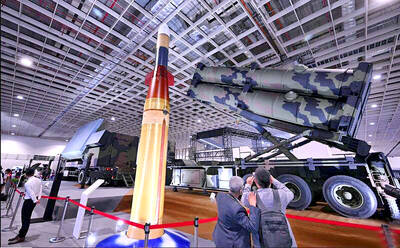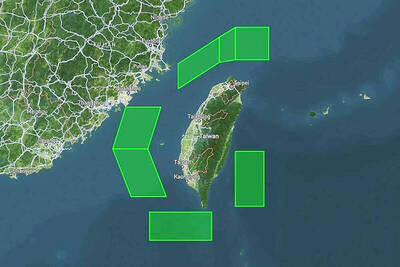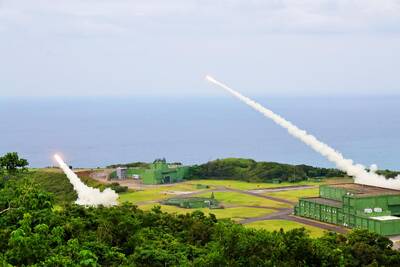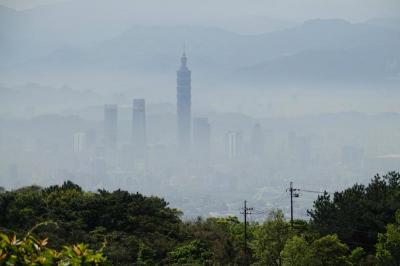The Maritime and Port Bureau said yesterday that it is scheduled to open 18 lighthouses to the public to turn them into tourist attractions.
At the beginning of this year, the management of the lighthouses was transferred from the Ministry of Finance’s Customs Administration to the Ministry of Transportation and Communications’ Maritime and Port Bureau.
Bureau Director-General Chi Wen-jong (祁文中), whose father worked as a keeper at the Chihou Lighthouse (旗后燈塔) in Greater Kaohsiung, said that the nation has 35 lighthouses, 34 of which are still in use and 11 are open to visitors.
“Tourists are banned from entering most lighthouses to prevent them from damaging lighthouse equipment. The facilities inside the lighthouse may not be safe for visitors, either,” Chi said. “However, they are allowed to enter the lighthouse grounds and take pictures. Some of the lighthouses do not have gates, so visitors can roam in the parks surrounding them.”
The bureau also announced during a ceremony yesterday that the Baisha Cape (白沙岬) Lighthouse in Taoyuan County and the Green Island Lighthouse are now open to visitors, while five more lighthouses would be opened over the next three years.
Democratic Progressive Party (DPP) Legislator Kuan Bi-ling (管碧玲) found through her research into the nation’s lighthouses a list of lighthouse keepers published by the Customs Administration in 1945, on which the name of Chi Wen-jong’s father, Chi Da (祁達), was listed.
She framed the list and presented it to him at the ceremony.
Chi Wen-jong said that he was “very surprised” to see the document and he knew very little about his father’s days as a lighthouse keeper.
“All I know is that my father was among the first group of local lighthouse keepers trained by the Customs Office in Shanghai and that he was later assigned to guard the lighthouse in Kaoshiung [now Greater Kaohsiung] for two years,” he said.
The nation’s lighthouses were all run by Britons at one point. His father would use gestures to communicate with his British colleagues, Chi Wen-jong said.
He said that his father later changed jobs, joining a shipping firm because life as a lighthouse keeper did not combine well with raising a family. Chi Da died at the age of 78.
To enrich lighthouse tours, Chi Wen-jong said that he plans to find other lighthouse keepers and ask them to tell their stories.
“My father kept an oil lamp that he used at work. I am sure his colleagues also kept similar items. Rather than letting family members throw these items away, we can collect them for an exhibit. We can also launch an oral history project to interview retired lighthouse keepers,” Chi said.
Baisha Cape was built more than 100 years ago with red bricks held together by a mixture of sticky rice, dark brown sugar and lime.

Taiwan is to commence mass production of the Tien Kung (天弓, “Sky Bow”) III, IV and V missiles by the second quarter of this year if the legislature approves the government’s NT$1.25 trillion (US$39.78 billion) special defense budget, an official said yesterday. Commenting on condition of anonymity, a defense official with knowledge of the matter said that the advanced systems are expected to provide crucial capabilities against ballistic and cruise missiles for the proposed “T-Dome,” an advanced, multi-layered air defense network. The Tien Kung III is an air defense missile with a maximum interception altitude of 35km. The Tien Kung IV and V

The disruption of 941 flights in and out of Taiwan due to China’s large-scale military exercises was no accident, but rather the result of a “quasi-blockade” used to simulate creating the air and sea routes needed for an amphibious landing, a military expert said. The disruptions occurred on Tuesday and lasted about 10 hours as China conducted live-fire drills in the Taiwan Strait. The Civil Aviation Administration (CAA) said the exercises affected 857 international flights and 84 domestic flights, affecting more than 100,000 travelers. Su Tzu-yun (蘇紫雲), a research fellow at the government-sponsored Institute for National Defense and Security Research, said the air

Taiwan lacks effective and cost-efficient armaments to intercept rockets, making the planned “T-Dome” interception system necessary, two experts said on Tuesday. The concerns were raised after China’s military fired two waves of rockets during live-fire drills around Taiwan on Tuesday, part of two-day exercises code-named “Justice Mission 2025.” The first wave involved 17 rockets launched at 9am from Pingtan in China’s Fujian Province, according to Lieutenant General Hsieh Jih-sheng (謝日升) of the Office of the Deputy Chief of the General Staff for Intelligence at the Ministry of National Defense. Those rockets landed 70 nautical miles (129.6km) northeast of Keelung without flying over Taiwan,

A strong continental cold air mass is to bring pollutants to Taiwan from tomorrow, the Ministry of Environment said today, as it issued an “orange” air quality alert for most of the country. All of Taiwan except for Hualien and Taitung counties is to be under an “orange” air quality alert tomorrow, indicating air quality that is unhealthy for sensitive groups. In China, areas from Shandong to Shanghai have been enveloped in haze since Saturday, the ministry said in a news release. Yesterday, hourly concentrations of PM2.5 in these areas ranged from 65 to 160 micrograms per cubic meter (mg/m³), and pollutants were